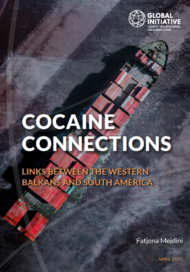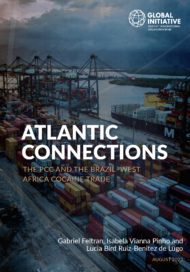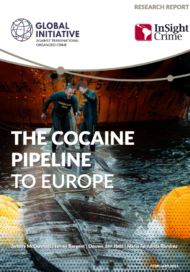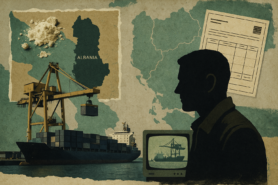Posted on 17 Nov 2025
The volume of cocaine seized in north-western European ports has fallen significantly in the last two years, following a decade of steady increases. From 2023 to 2024, Rotterdam reported a roughly 40% decrease in seized cocaine, Antwerp recorded a fall of more than 60% and Germany – with Hamburg as the country’s main entry point – saw a decline of over half. This trend has continued in 2025. In recent years, these three major European ports had become the main gateway for cocaine into the continent. Can Europe now celebrate having turned the tide on the ‘white tsunami’?
The answer is, unfortunately, no. What can be observed from the declining amounts seized is criminal adaptation at its finest. These three ports have invested heavily in efforts to disrupt cocaine trafficking, including creating new cooperation initiatives such as the European Ports Alliance. In addition, containers originating in Latin American ports are undergoing enhanced scrutiny, such as documentary control and physical inspection; the port of Rotterdam has introduced the Secure Chain initiative to combat corruption and PIN code fraud; and Hamburg has established a Port Security Centre.
All these measures should increase the risk for criminal groups. However, cocaine prices have dropped sharply at retail and wholesale levels in some western European countries, while demand remains stable or continues to growoversupply of cocaine in Europe rather than a shortage, as traffickers sidestep disruption efforts at the ports. This pattern is consistent with rising cocaine production in key supply hubs such as Colombia. Preliminary observations indicate three key trends in the European cocaine market that are linked to an overall trend of oversupply and criminal adaptation.
First, criminal actors have realized that multi-tonne shipments pose a major risk to their operations. Consequently, they are increasingly relying on smaller, more frequent shipments to minimize losses. For example, Dutch authorities report that in 2021 a total of 22 cocaine shipments of more than a tonne were seized, whereas this number decreased to eight in 2024. During the same period, intercepted cocaine shipments weighing less than 100 kilograms increased from 89 in 2022 to 115 in 2024. Similar patterns can be observed elsewhere in Europe.
Second, in order to reduce the risk of interception, traffickers are increasingly using alternative ports connected to transit corridors. This phenomenon is known as the ‘waterbed effect’, whereby increased disruption efforts on one route lead to trafficking being diverted towards others. Europe is also witnessing a new expansion towards northern Europe, the Baltic Sea and south-eastern Europe via, for example, ports in Sweden, Poland, Greece and Türkiye. This suggests that the upsurge in security efforts at Europe’s major ports has spread the problem across Europe as a whole. This is particularly evident when considering the secondary effects of shifting cocaine flows, such as the influx of foreign criminal actors, increased competition and criminal violence, heightened corruption threats and more availability of potentially cheaper cocaine.
The third trend is that traffickers are increasingly diversifying their concealment methods. Alternative methods to containerized trafficking include drop-offs at sea, the use of bulk carriers or car ferries, and concealing cocaine underwater on ship hulls. Traffickers are also increasingly using liquified or otherwise chemically altered cocaine to make it appear to be legal cargo such as coal or wine. In other cases, they hide the loads inside consumer items such as furniture or electronics. These methods make detection by standard container scanners and sniffer dogs difficult, thwarting interdiction efforts.
Europe has seen a rise in such methods at the same pace as cocaine extraction laboratories have been detected. While these laboratories were originally concentrated in Spain, many other EU member states have now seen the emergence of such facilities, for example the Netherlands, France, Belgium and Greece. Beyond the imminent detection challenges, the growing number of cocaine laboratories is also a sign of a more worrying trend: the nearshoring of the Latin American cocaine industry closer to consumer markets in Europe.
The surge in the number of cocaine processing laboratories in Europe has been accompanied by a growing presence in the continent of Latin American criminal organizations, such as the Brazilian Primeiro Comando da Capital, the Colombian Clan del Golfo and the Mexican Sinaloa cartel. This trend is not limited to cocaine; for example, methamphetamine production sites with links to Mexican organized crime have recently been discovered in France and Poland. In the Netherlands, known operations with links to Mexican organized crime date back to 2019.
All of these trends point to the resilience of the European cocaine market. Although Europe’s three major ports have taken action to interdict cocaine in recent years, other parts of the continent are at risk of paying the price for their successes. Europe needs to reconsider how to balance national initiatives with collective regional interests. Strengthening Europol’s mandate, building on Eurojust tools and supporting regional port security efforts such as the European Ports Alliance are all steps in the right direction to avoid being further outsmarted by the adaptation efforts of organized crime groups. Better intelligence and foresight will be critical if the strategy is to work.



